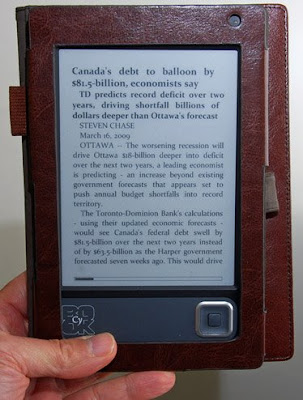One problem we considered when planning our sojourn in Italy was, how to feed the TV habit? Not that either of us is a hardcore addict, but we do like to watch an hour or so of television in the evening – almost always something recorded on the PVR.
Our Italian isn't good enough to watch local TV and there was no reason to think we'd get any English-language TV from the cable service at the apartment we rented. (We were right about that.) So what was the solution?
I've already talked about a possible Internet-based solution,
Slingbox, which streams TV from your home service over the Internet to your computer. While the quality of video is okay for watching the news, say, it's probably not good enough to watch an entire episode of House or a movie.
Another possibility is watching programs streamed from Web sites of TV networks or aggregators such as
hulu.com. There is actually quite a bit available, but that solution is fraught with other, copyright-related problems that I'll discuss in a future post.
So what did we do? Before we left, we borrowed DVDs from our local public library - movies and recorded TV seres - and ripped them to an impossibly tiny but capacious hard drive using a program called AnyDVD from
Slysoft. The hard drive is the
FreeAgent Go from Seagate, small enough to fit in a shirt pocket. It is currently holding 50 or 60 hours of high-quality video.

Here's a shot of the modified home theatre set-up in our apartment, showing the laptop, FreeAgent Go and components that were already here. In future posts, I'll talk about the ripping process and our experience watching recorded material over here, but before closing, I want to say a word about legality and ethics.
In the U.S., rightly or wrongly, it is illegal to rip DVDs. Which means that the software for doing it is illegal too. (This is why software providers like Slysoft, which is based in Barbados, tend to be offshore.)
In Canada, according to legal experts I consulted a few years ago when researching the question for a story I was writing, it is perfectly legal to copy copyrighted material for personal use. You just can't distribute it. That's under current law. New iron-fisted, American-style legislaton is probably coming that will make DVD ripping just as illegal in Canada.
What about ethics? It's not as if we're doing anything more with the programs we ripped than we would if we had just borrowed them from the library and viewed them at home. We're
not distributing them. In most cases, we'll watch them once and delete them from the hard drive. Having them recorded simply means we can watch at our leisure, whereas the library has a one-week loan period. But that loan period isn't imposed for any reason of copyright, only because DVDs are in such high demand.


























 When we were ready to leave, we discovered that buses back to Siracusa were nowhere near as frequent as we had imagined. We had to wait over an hour and a half. Part of the time we spent on a bench in the pretty little Giardini Publicci, watching the kids play and munching beer nuts bought from a peddlar in the park.
When we were ready to leave, we discovered that buses back to Siracusa were nowhere near as frequent as we had imagined. We had to wait over an hour and a half. Part of the time we spent on a bench in the pretty little Giardini Publicci, watching the kids play and munching beer nuts bought from a peddlar in the park.




 However, I can tell you that Obamamania came to Via Mirabella, Siracusa. Even I, the political cynic, wanted to hear what the new president would say. So we hooked up the laptop to the TV in the livingroom (see post below) and surfed to the CTV (Canadian television network) Web site. CTV was offering a special live stream of the proceedings. We put it in full-screen mode and the video and audio quality were amazingly good – a little soft focus, occasional blips in the motion, blurring in fast motion such as when the crowd waved their flags, but perfectly watchable, and every word was audible. The screen grab above gives you an idea of what we saw.
However, I can tell you that Obamamania came to Via Mirabella, Siracusa. Even I, the political cynic, wanted to hear what the new president would say. So we hooked up the laptop to the TV in the livingroom (see post below) and surfed to the CTV (Canadian television network) Web site. CTV was offering a special live stream of the proceedings. We put it in full-screen mode and the video and audio quality were amazingly good – a little soft focus, occasional blips in the motion, blurring in fast motion such as when the crowd waved their flags, but perfectly watchable, and every word was audible. The screen grab above gives you an idea of what we saw. 





